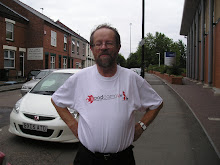 Today we finally did a bit of real sightseeing stuff and went to Blickling Hall. No, not Blinking, but Blickling, which is a marvellous old house/mansion/stately home near Aylsham (pronounced Aylsham!).
Today we finally did a bit of real sightseeing stuff and went to Blickling Hall. No, not Blinking, but Blickling, which is a marvellous old house/mansion/stately home near Aylsham (pronounced Aylsham!). It’s a Jacobean house, which means it’s nearly four hundred years old – it was built between 1616 and 1627 – but it’s in great condition, and much of the original interior is as it was when it was built. There have been numerous alterations as well – like my wife, the owners of this house have never been content to keep it as it was – and the main staircase in the front hall is different to the way it began, and now goes in a different direction; various bathrooms have been substantially altered and rooms that were something before are now something else. Sounds so much like our place!
The house is full of paintings – most of them portraits, including one of Henry VIII by Holbein. There are a couple of Van Dyks, and no doubt there are other famous ones that I missed noting because I was overawed by the place.
The library is a massive long room with a plaster ceiling, which has a basic pattern to it, but between the pattern are a considerable number of separate sculptured sections of people and insignias and so forth. Below this is a painted frieze that goes all the way round the hall; it must be very early as the colours have faded a good deal and the detail isn’t as clear as it would have been. Below this again are some 12,000 books, scholarly works that a cousin of the then owner collected.
The plaster ceilings throughout the house are extraordinary, filled with detail, as are the fireplaces, some of which stretch from floor to ceiling. They’re enormous works of art, two or three metres wide, and three or four metres high.
The house we saw today is the second to built on the site: the original house was substantially pulled down and rebuilt for the
I said to Celia on the way into the building: this is like the setting for some film, and it turns out the The Wicked Lady, with Margaret Lockwood and James Mason, was filmed there in 1945.
Blickling Hall – and 4,500 acres of estate - was left to the National Trust in 1940. It was used as an Officers’ Mess during the War, and finally opened to the public in 1962.
For more detail on its history, click here.

No comments:
Post a Comment